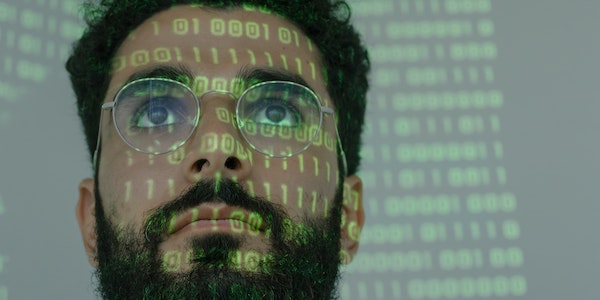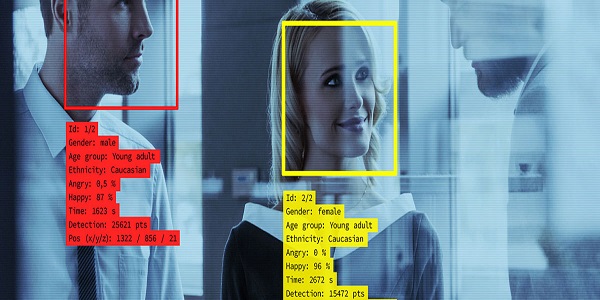Introduction
Authentication is a very crucial part of this technological world. Many tech stacks and framesets are created to avoid the unimaginable circumstances caused by their wrong use. They are continuously struggling to develop an effective and efficient application. But there is a problem with the developers: they pay less attention to developing more innovations or creating a reliable authentication system.
Artificial and machine learning techniques and advancements have made face recognition popular. Face recognition is easy to implement, and it’s a reliable system too. Most smartphones now use optical facial recognition techniques to unlock the phone and protect our important data. In smartphones, this facial recognition can become a source to protect important data and files, for example, present in our emails, drive, etc. But in the field of website development, we can’t see the adoption of this technology becoming the norm for authentication.
 Source: Freepik
Source: Freepik
In this article, I’ll go through the benefits of using facial recognition software, the FACEIO app specifically, its features, implementation of FACEIO, and its pros & cons.
Learning Objectives
- Understand the importance and some basic features of the FACEIO App.
- Learn the working phenomena of the FACEIO App, including the verification and identification process.
- Understand the stages involved in the recognition and identification process.
- Learn how FACEIO App is implemented on your browser.
- Develop the ability to integrate FACEIO on your preferred browser using JS functions.
- Gain hands-on experience by implementing FACEIO App on your browser in 4-steps
This article was published as a part of the Data Science Blogathon.
Table of Contents
- Introduction & Authentication with FACEIO App
- History of Facial Recognition
- Key Features of FACEIO
- Working of FACEIO
4.1 Verification
4.2 Identification - Four Stages of Authentication Method
5.1 Capture
5.2 Extraction
5.3 Comparison
5.4 Match / No Match - Implementation of FACEIO
6.1 Image Acquisition
6.2 Image Processing
6.3 Distinctive Characteristic Location
6.4 Template Creation
6.5 Template Matching
- Integration of FACEIO
7.1 Step 01: Importing fio.js to your site
7.2 Step 02: Instantiating a new FACEIO object
7.3 Step 03: Invoking the FACEIO widget - Basic Steps for Application
- Conclusion
- Links to Get Started
Authentication with FACEIO App

FACEIO is a facial authentication system that can be implemented on a website using a webcam through JavaScript (Just like Disqus or Google tag) to help the users easily authenticate with the help of face recognition, unlike other traditional ways of authentication that involve passwords, emails, etc.
Simply put, it is easy to add passwordless authentication to your device. It is a straightforward widget with a luxurious UI to provide a facial recognition experience to the users. This widget is powered by the fio.js JavaScript library, which shows the following characteristics: i.e., it can be integrated within five minutes and is flexible enough to support highly personalized configurations. Once you are familiar with this system and have successfully implemented it on your websites, it will help you to enroll in upcoming years, feel convenience in using your favorite browser, and, yes, a definite thanks to this technology of passwordless authentication development.
History of Facial Recognition

The technology behind face recognition is older than 50 years. The first semi-automatic approach for facial recognition characteristics in photos or pictures, like eyes, ears, nose, and mouth, was developed in the 1960s. Initially, the aim was to analyze if a computer could use a database of 10 images of different people to identify new photos of each person correctly. Goldstein and Harbor using 21 subjective characteristics, including hair, lips, cheeks, and color automation developed the recognition in the 1970s. Although this was a breakthrough in the tech world, the location was still calculated manually. The traditional linear algebraic techniques for face recognition were applied in 1980 by Kirby and Sirovich. Applications of facial recognition technology are growing exponentially, and the technology itself is evolving at a swift pace. When used correctly, facial recognition technology can dramatically improve the quality of our lives and our interactions with the world around us.
Key Features of FACEIO App

Source: Pexels
- FACEIO App is a FIDO KEY, OTP, and question-free authentication system.
- FACEIO App has comprehensive browser compatibility (Chrome, Safari, Edge, and Chromium derivatives). It can be integrated with a browser that users prefer to use for authentication.
- It is a authoritative technology only used in JavaScript & CSS and is unreliable on outside sources.
- It is a modern facial recognition system that ensures defense-grade accuracy and provides a speed of fewer than 100 milliseconds.
- FACEIO has the highest possible safety and protection requirements. Privacy by design while maintaining the highest possible level of user ease.
- FACEIO App has been working to provide eye gesture recognition.
- It does not need biometric sensors.
- The users control the security levels, but it ensures its safety.
- FACEIO is the only application providing face recognition services online.
Working of FACEIO App

Source: Freepik
FACEIO requires a front camera or webcam for its verification process. For face recognition, it does not need IR blast sensors. Regardless of all the framesets, the websites exhibit 100% efficiency.
Face recognition requires two types of comparisons:
- Verification:In this process, the user provides information to the system, and then the system verifies the user’s information before allowing the user access. If the user’s information is inaccurate, the system gives him three opportunities to prove his identity before sending an email to the actual user.
- Identification:It’s a system that compares the user’s input to the data stored in its database; if a match is found, the user’s identification is complete; otherwise, the user is given three chances to try again before being locked out permanently or being notified through email that an unauthorized third party has tried to breach the user’s privacy.
Four Stages of Authentication Method

Source: pexels.com
Four stages are involved in the recognition and identification process. They are as follows:
- Capture:The system captures a person’s physical or behavioral characteristics while enrolling and the identifying process. These details are saved in the system’s database and can be used in further recognition techniques.
- Extraction:The template is produced by extracting particular data like physiological or behavioral features, including eye distance, forehead-to-chin distance, nasopharyngeal distance, depth of eye sockets, and shape of cheekbones, lips, ears, and chin.
- Comparison:After this, a new sample is compared with a template, and using the comparison’s findings, the system automatically runs machine learning to strengthen the authentication mechanism.
- Match / No match:When the system receives samples, it checks them against the information in its database to see if the characteristics match or do not match the sample provided. When the results are in, the next steps are taken accordingly.
Implementation of FACEIO App

Source: pexels.com
The implementation of FACEIO involves five main stages. They are discussed as under:
- Image Acquisition: Any static camera that provides a good quality image and resolution may capture the faces using face scan technology. The quality of the enrolled datasets defines the facial characteristics employed in the recognition process. Identification of enrolled pictures is crucial for the verification process.
- Image Processing: The photographs are converted to black and white so that the grayscale properties may be analyzed. The resulting image is a round representation of the face. Once the face has been identified, it is localized using a normalization approach and compared to the sample from the template.
- Distinctive Characteristic Location: All existing face recognition systems attempt to mimic human recognition by comparing and matching external facial characteristics. Facial-scan systems often focus on the areas close to the eyes, the corners of the mouth, the profile of the nose, and the relative positions of the eyes, nose, and mouth. Changes in a person’s outward look, including a new hairstyle, makeup, or glasses, can mislead facial-scanning algorithms and make accurate identification difficult or impossible.
- Template Creation: Enrollment templates are commonly created using various processed facial photographs. Some manufacturers can even provide templates that are fewer than 100 bytes in size, while others may produce templates that are over 3K in size. In physiological biometrics, the 3K template is the most comprehensive option. Usually, bigger templates are linked to behavioral biometrics.
- Template Matching:A comparison is made between Match and Enrollment templates. To provide a user with 10–20 match attempts in 1–2 seconds while performing 1:1 verification in a facial-scan system, many photographs are taken and scored against the database. The results of facial-scan identification include several probable matches since a facial scan is less successful than a finger or iris-scan at identifying a single person from a big database.
Integration of FACEIO App

For most of the users, fio.js integration is a breeze.
Step 01
Importing fio.js to your site
Use the following code snippet in your body tag to connect to the FACEIO CDN:
const faceio = new faceIO(“app-public-id”);
Step 02
Instantiating a new FACEIO object
Use the following snippet to instantiate a new face object on your website and replace the parameter “app-public-id” with your public ID found in the FACEIO console.
/* Simply provide the Public ID for your application when launching fio.js */ const faceio = new faceIO(“app-public-id”);
Step 03
Invoking the FACEIO widget
You can use the enroll() method to enroll unpracticed users on your website, and the authenticate() method can authenticate existing users through facial recognition.
Authenticate User
const faceio = new faceIO(“app-public-id”);
function enrollNewUser(){
// call to faceio.enroll() will provoke the onboarding process
}
function authenticateUser(){
//call to faceio.authenticate() will provoke the authentication process
}
function handleError(errCode){
// Handle error here
}
Enroll New User
Now Implement the enroll()from Client-Side JavaScript
// Instantiate a new faceIO object with your application’s Public ID
const faceio = new faceIO(“app-public-id”);
function enrollNewUser(){
faceio.enroll({
“locale”: “auto”, // Default user locale
“payload”: {
“whoami”: 123456, // Dummy ID linked to this particular user
“email”: “[email protected]”
}
}).then(userInfo => {
// User Successfully Enrolled!
alert(
`User Successfully Enrolled! Details:
Distinct Facial ID: ${userInfo.facialId}
Enrollment Date: ${userInfo.timestamp}
Gender: ${userInfo.details.gender}
Age Approximation: ${userInfo.details.age}`
);
console.log(userInfo);
}).catch(errCode => {
handleError(errCode);
})
Basic Steps for Application
Step 01
You’ll first need to register on the FACEIO dashboard. Select the NEW FACEIO APP after logging in, see Figure #1 below.
Complete the steps of the FACIO Application Wizard and provide the necessary information. However, we may deselect this option if we don’t want the user to re-enter the PIN after successful recognition.
Figure #2 shows that the user may choose from various solutions depending on their specific needs.
Get a public ID in the format shown in Figure 3. Nevertheless, this is arguably the most important part of the application.
Step 04
To begin using fio.js for face authentication on your site, you must first import the library, provide it with your application’s Public ID, and then run your first authentication operation.
Please visit faceio.net/integration-guide for access to the official integration guides and example code.
Conclusion
In the end, we find this to be the fastest (less than 100 ms) and safest (no personal information is stored) facial recognition approach. It uses a little JavaScript to be integrated into the website. We are witnessing the rise of a more technological, cutting-edge alternative to the time-honored practices of using paper and pen or meeting face-to-face.
Compared to the time-consuming approaches of the past—including one-time passwords, email verification, and many others—FACEIO has shown to be a time-saver. It is the best way of focusing on face recognition and giving you access to your favorite browser in seconds.
Additionally, FACEIO ensures complete privacy and protection of the user’s data. If user samples cannot be matched, FACEIO uses the same dataset and provides no feedback. It’s a webcam-based authentication system. Thus, no other sensors are necessary.
Some of the Important Key Takeaways:
- FACEIO is a cross-browser authentication system that validates user IDs using face recognition.
- FACEIO may be embedded with JavaScript’s library Enroll and Authenticate function.
- FACEIO uses in-your-face or webcams. Facial recognition can be done without infrared blasters.
- Traditional user authentication is complex and time-consuming. Easy and safe authentication is now possible with FACEIO.
Links to Get Started
FACEIO In Under 5 Minutes: Getting started with the basics is always the best place to begin.
FACEIO Integration Guide: Examine the fio.js package, which may be used for face recognition on your website.
Developer Center: To integrate FACEIO into your website, you may need the available documentation, code snippets, and tools.
FAQs: Questions? Get them answered quickly here.
Trust Center: Find out how we protect your personal information and keep it private.
The media shown in this article is not owned by Analytics Vidhya and is used at the Author’s discretion.







